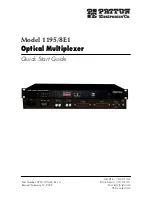
I. SDLC/HDLC Protocol
154001UA
I-25
ERROR CONDITIONS
ERROR CONDITIONS
ERROR CONDITIONS
ERROR CONDITIONS
ERROR CONDITIONS
IN THE MULTIPLEXER
IN THE MULTIPLEXER
IN THE MULTIPLEXER
IN THE MULTIPLEXER
IN THE MULTIPLEXER
If incoming data on an SDLC/HDLC channel cannot be removed from the line fast
enough to maintain the channel speed, an overrun condition occurs and the
current frame is considered to be lost. This condition is propagated to the remote
end as a bad CRC.
Receiver Overrun
Receiver Overrun
Receiver Overrun
Receiver Overrun
Receiver Overrun
No Buffer Available (for
No Buffer Available (for
No Buffer Available (for
No Buffer Available (for
No Buffer Available (for
Output on Link)
Output on Link)
Output on Link)
Output on Link)
Output on Link)
If no output buffer is available for data from an SDLC/HDLC channel, the data is
lost and transmission of the current frame from that channel is terminated. The
remainder of the incoming frame is discarded. The remote multiplexer will detect
either a transmission underrun condition (refer to Transmission Underrun sec-
tion), in which case an abort will be inserted into the outgoing frame, or it will
detect the start of the next frame on that channel before the current frame has
terminated, in which case a BAD CRC will be generated into the outgoing frame.
Transmission Underrun
Transmission Underrun
Transmission Underrun
Transmission Underrun
Transmission Underrun
When transmitting on an SDLC/HDLC channel, if the multiplexer or the link
cannot supply data fast enough to maintain the line rate on the channel, an
underrun condition occurs and the current frame is considered to be lost. The
multiplexer indicates this condition to the DTE by sending an abort on the chan-
nel.
RECOMMENDA
RECOMMENDA
RECOMMENDA
RECOMMENDA
RECOMMENDATIONS
TIONS
TIONS
TIONS
TIONS
DSR
(Data Set Ready). Due to the sensitivity of SDLC/HDLC lines to DSR, it is
recommended that this EIA signal be forced high on both 2031s.
CTS
(Clear To Send). As stated in the CTS-RTS section, it is recommended that
both 2031s be configured for CTS-RTS. Table I-1 shows the priorities if the han-
dling of the signal.
CHANNEL RESET
. When a channel is reset via the CRT or Front Panel, all forced
leads will be cleared. This means that DSR may drop. Although both the local and
the remote channels will be reset, the leads will only be cleared on the local
channel. Therefore, if a channel reset needs to be performed, it should be per-
formed on the less critical side (the controller as opposed to the FEP, for example).









































